ASUS X99-A Motherboard Review
by Ian Cutress on December 22, 2014 2:00 PM EST- Posted in
- Motherboards
- Intel
- Asus
- Haswell-E
- LGA2011-3
Gaming Performance
F1 2013
First up is F1 2013 by Codemasters. I am a big Formula 1 fan in my spare time, and nothing makes me happier than carving up the field in a Caterham, waving to the Red Bulls as I drive by (because I play on easy and take shortcuts). F1 2013 uses the EGO Engine, and like other Codemasters games ends up being very playable on old hardware quite easily. In order to beef up the benchmark a bit, we devised the following scenario for the benchmark mode: one lap of Spa-Francorchamps in the heavy wet, the benchmark follows Jenson Button in the McLaren who starts on the grid in 22nd place, with the field made up of 11 Williams cars, 5 Marussia and 5 Caterham in that order. This puts emphasis on the CPU to handle the AI in the wet, and allows for a good amount of overtaking during the automated benchmark. We test at 1920x1080 on Ultra graphical settings.
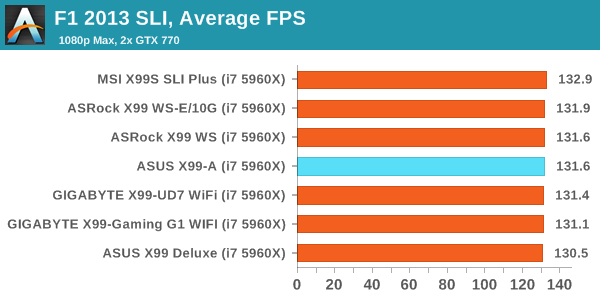
Bioshock Infinite
Bioshock Infinite was Zero Punctuation’s Game of the Year for 2013, uses the Unreal Engine 3, and is designed to scale with both cores and graphical prowess. We test the benchmark using the Adrenaline benchmark tool and the Xtreme (1920x1080, Maximum) performance setting, noting down the average frame rates and the minimum frame rates.
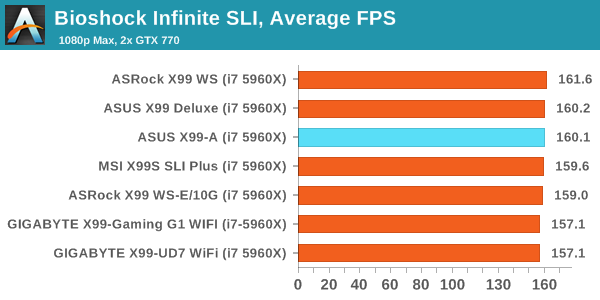
Tomb Raider
The next benchmark in our test is Tomb Raider. Tomb Raider is an AMD optimized game, lauded for its use of TressFX creating dynamic hair to increase the immersion in game. Tomb Raider uses a modified version of the Crystal Engine, and enjoys raw horsepower. We test the benchmark using the Adrenaline benchmark tool and the Xtreme (1920x1080, Maximum) performance setting, noting down the average frame rates and the minimum frame rates.
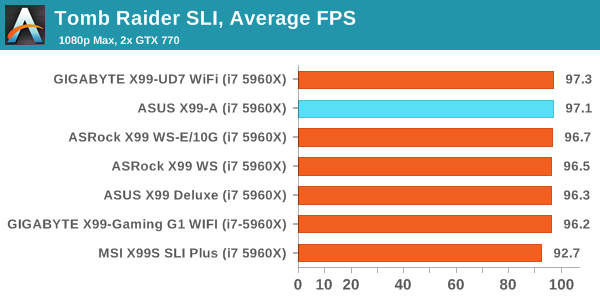
Sleeping Dogs
Sleeping Dogs is a benchmarking wet dream – a highly complex benchmark that can bring the toughest setup and high resolutions down into single figures. Having an extreme SSAO setting can do that, but at the right settings Sleeping Dogs is highly playable and enjoyable. We run the basic benchmark program laid out in the Adrenaline benchmark tool, and the Xtreme (1920x1080, Maximum) performance setting, noting down the average frame rates and the minimum frame rates.
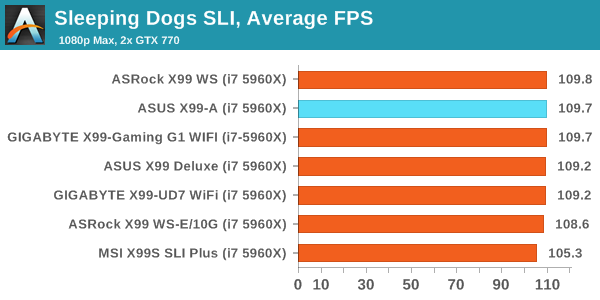
Battlefield 4
The EA/DICE series that has taken countless hours of my life away is back for another iteration, using the Frostbite 3 engine. AMD is also piling its resources into BF4 with the new Mantle API for developers, designed to cut the time required for the CPU to dispatch commands to the graphical sub-system. For our test we use the in-game benchmarking tools and record the frame time for the first ~70 seconds of the Tashgar single player mission, which is an on-rails generation of and rendering of objects and textures. We test at 1920x1080 at Ultra settings.
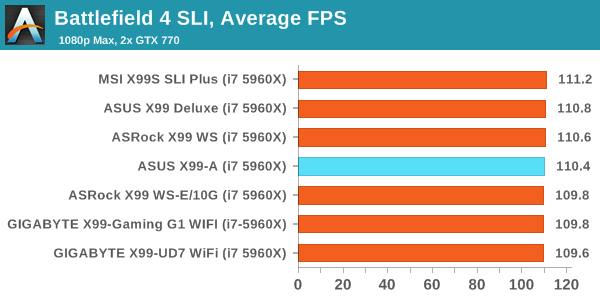















37 Comments
View All Comments
Aibohphobia - Monday, December 22, 2014 - link
Could you make more clear that while all the fan headers will power a PWM fan only the CPU headers actually function in PWM mode?You can look in the manual and see that all the Chassis headers are +5V on the fourth pin (100% duty cycle) and is using only voltage on the second pin for speed control. Of the Asus X99 boards only the Extreme has PWM control on all headers.
GeorgeH - Monday, December 22, 2014 - link
Asus is bragging about the "OC Socket" in their X99 motherboards, but so far it seems like snake oil. Any further comment beyond what was in the Deluxe review?Rajinder Gill - Monday, December 22, 2014 - link
The manual needs updating. Full PWM and DC control is offered on all CPU and chassis fan headers on the ASUS X99 series.-Raja
Aibohphobia - Monday, December 22, 2014 - link
I know both PWM and DC fans can be controlled, but is there an actual PWM signal on the 4th pin?The ROG Z97 boards were supposed to be full PWM control too but the Maximus VII Impact manual was updated in October and it still shows +5V on the 4th pin for the chassis headers as well.
vred - Monday, December 22, 2014 - link
Z97-WS can control PWM-fans using PWM signal, since I connect multiple fans to the same chassis header via the splitter which takes power from a Molex plug, and PWM signal from the motherboard, and RPM control works. I would assume X99 motherboards have the same functionality. Must be an error in the user manual.Rajinder Gill - Tuesday, December 23, 2014 - link
There is full pwm and dc mode on the headers - user selectable(it is a pwm signal on the pin when pwm mode is set for the header). The manual is wrong and needs correcting.Aibohphobia - Tuesday, December 23, 2014 - link
Awesome, that's great to hear. I got both a EVGA and Gigabyte X99 board recently and I was disappointed to find both had only PWM on the CPU header. I'll look forward to possibly switching back to Asus in the future.Grayfenix - Friday, January 9, 2015 - link
That is incorrect. All fan headers are capable of pwm. Switching back and forth in bios now.DanNeely - Monday, December 22, 2014 - link
What's with the Gigabyte board's horrible score in the 2nd Rightmark Audio test? There're a pair of **'s on the graphic implying a footnote explanation; but I can't find one.HollyDOL - Tuesday, December 23, 2014 - link
I would be interested in that too... it though seems like malfunctioned product judging by values presented.It would be also nice to see comparison with dedicated sound cards both synthetically and on ear test. I have yet to hear an integrated audio that doesn't sound terrible if you try to play it on a higher range amplifier (Hi-Fi/audiophile) and speakers (with appropriate cables). But that can hardly be evaluated objectively, we all hear a bit different.